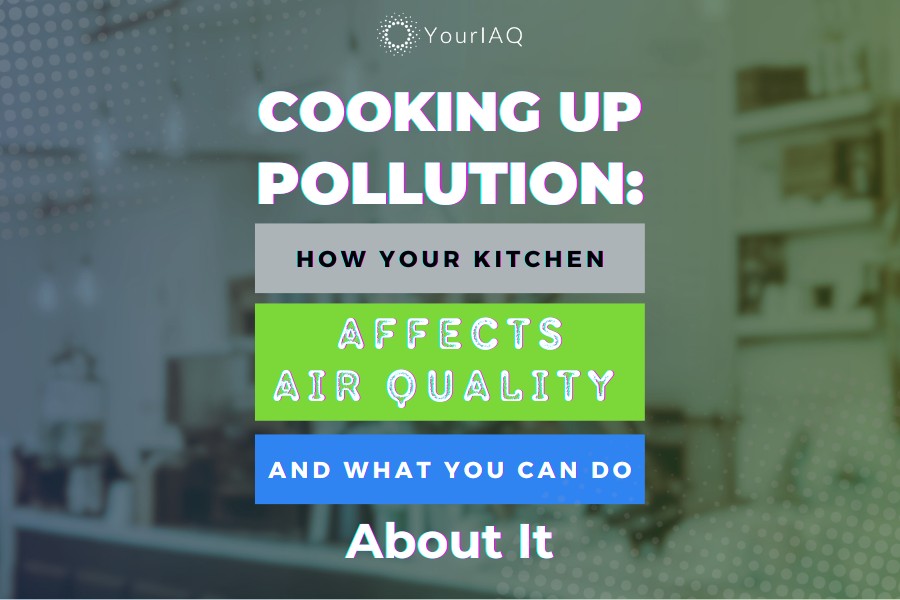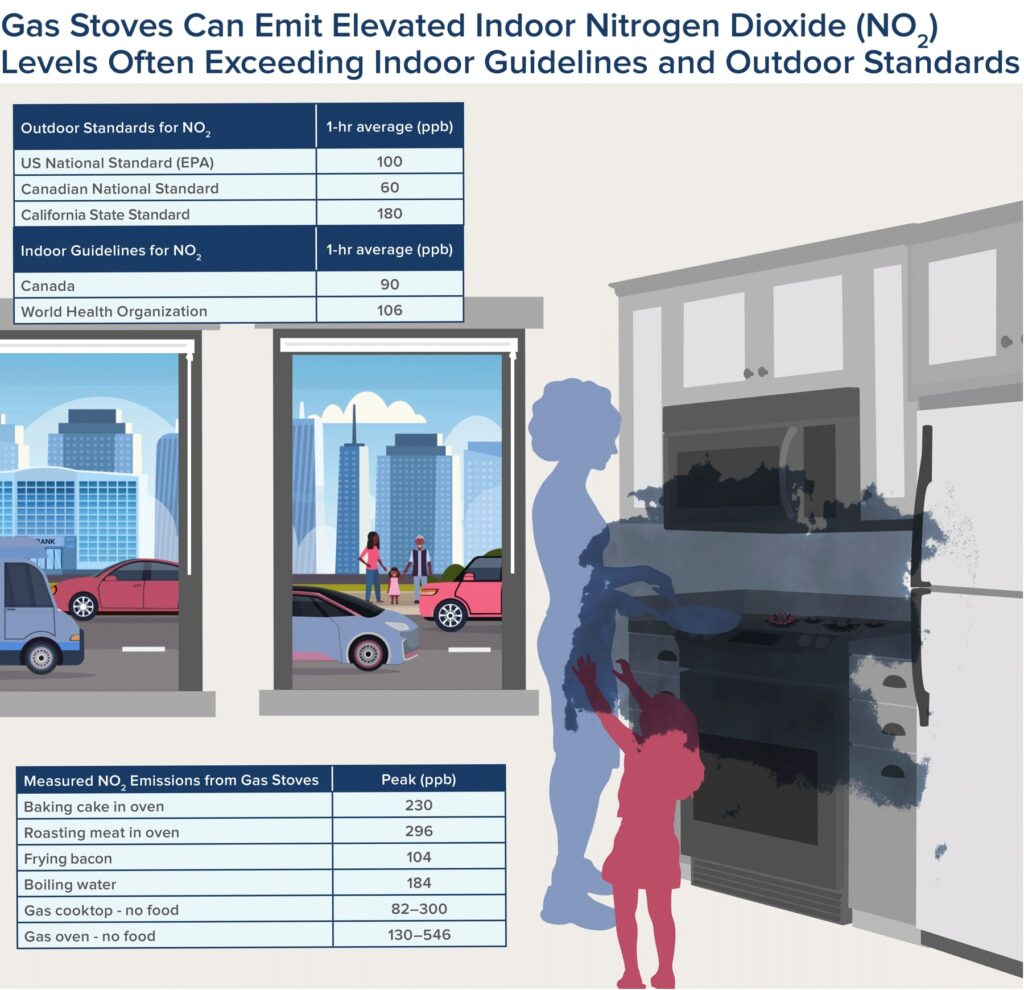
I used to love the sizzle and aroma of cooking. But then, the enticing smells were joined by a faint acrid note…a tickle in my throat that turned into a cough…Then a realization hit me: could poor kitchen air quality be the reason?
I’m sure much like I did, many also assume that their kitchen is a haven. However, the truth is that it can harbor a surprising amount of indoor air pollutants. From charcoal stoves in remote villages to gas burners in city kitchens, and even rising vapor from modern electric griddles—all share the potential to degrade the air we breathe.
People in the United States spend about 65% of their time in their residences and about 90% indoors – meaning our kitchens have a major impact on our overall air quality. Over time, this affects our respiratory health and overall well-being.
The impact on our lungs might be gradual, but it’s real.
Studies show that gas stoves can release nitrogen dioxide levels several times higher than the EPA’s outdoor safety limits within a short time. Just recently, New York was the first state that pass a new law banning gas stoves and furnaces in new buildings citing health concerns and GHG emissions. Additionally, exposure to particulate matter from cooking fumes has been linked to a 20-40% increased risk of developing asthma.
It’s time to examine your favorite cooking activities and learn how and why they become a pollution hotspot. Let’s explore the sources of kitchen air pollution and find simple, effective ways to create a healthier environment.
Gas Stoves: Hidden Health and Climate Dangers
While gas stoves offer convenience, they have hidden costs for our health and the environment. Here’s why it’s crucial to understand the risks lurking in your kitchen:
Methane: A Continuous Climate Threat
Gas stoves seem like essential kitchen tools but have a hidden climate and health cost. One major concern is methane, the primary component of natural gas. You might think the risk is only when the stove is on, but surprisingly, research shows most methane leakage happens even when your stove is off.
Gas Stoves Leak Methane Even When Off
A recent Stanford University study found that most gas stove emissions happen when the stove is turned off. They traced the leaks to fittings, connections, and gas lines. Researchers found the little puffs of gas released while turning a burner on and off were equivalent to about 10 minutes of continuous burner use.
The Dangers of Methane Exposure
Many studies show methane leaks occur throughout the natural gas system, from extraction to your home’s gas lines. The crucial point to remember is that methane is odorless, so you might not detect a leak even if it’s happening. This can be especially dangerous because methane can seep into your home.
In high or lower concentrations over a prolonged period, methane can displace oxygen in the air inside your home. This can cause a range of symptoms:
- Mild to Moderate Exposure: Mood changes, slurred speech, vision problems, memory loss, nausea, vomiting, facial flushing, and headache.
- Severe Exposure: Changes in breathing and heart rate, balance problems, numbness, unconsciousness, and in the most extreme cases, death.
While we often focus on what happens while we cook, methane is a concern even when the stove is idle. Let’s look at the other harmful substances your gas stove releases during use.
Harmful Combustion Byproducts When the Stove is On
While we often focus on what happens while we cook, methane is a concern even when the stove is idle. Let’s look at the other harmful substances your gas stove releases during use.
Nitrogen Dioxide (NO2)
The biggest concern for human health is nitrogen dioxide (NO2).
NO2 gas is produced when natural gas is burned at high temperatures in the presence of nitrogen in the atmosphere. Exposure to nitrogen dioxide irritates the lungs and exacerbates conditions like asthma, especially in children and older adults. Natural gas combustion also releases other harmful substances, including nitrogen oxide, carbon monoxide, and formaldehyde.
Unregulated Indoor Air Pollution
It’s important to understand that the Environmental Protection Agency (EPA) sets limits on outdoor NO2 levels, but there are no similar standards for indoor exposure. This means the level of nitrogen dioxide in your kitchen could be significantly higher than what’s considered safe outdoors.

Beyond Gas: How Your Cooking Impacts Air Quality
The dangers of gas stoves extend beyond the stove itself. Let’s explore how your cooking methods and food choices affect your kitchen’s air quality.
Frying & Grilling: High Pollution Techniques
While gas stoves get a lot of attention, it’s important to know that cooking itself – regardless of your stove type – impacts indoor air quality. Certain cooking techniques are more prone to generating air pollution. Frying and grilling, especially at high temperatures, release significantly more pollutants than steaming, boiling, or baking.
Furthermore, frying, grilling, and even boiling water can generate fine particulate matter known as PM2.5. These tiny particles can penetrate deep into the lungs and cause or worsen respiratory problems.
Don’t Overheat Your Oils
When cooking oils are heated past their smoke point, they break down and release harmful fumes, including volatile organic compounds (VOCs) and aldehydes. These pollutants cause respiratory irritation, and headaches, and increase the risk of long-term health problems.
Burned Food: A Major Air Quality Offender
Sadly, even the most careful cook occasionally burns their food. When food burns, it creates large amounts of particulate matter (PM), worsening indoor air quality and exacerbating respiratory problems.
Cooking Pollution: The Health Risks
The research is clear: exposure to pollutants from cooking can have immediate and long-term health consequences. This is especially true in smaller homes or those with inadequate ventilation.
Eye and throat irritation, headaches, and nausea can be common after spending time in a poorly ventilated-kitchen. Studies link cooking-related pollution to increased risk of asthma and other respiratory illnesses.
Best Solutions for Cleaner Kitchen Air: Your Action Plan
It’s time to take action! Here’s your plan for a healthier kitchen environment.
Ventilation: Your Best Defense
Ventilation is your primary defense against the build-up of cooking-related pollutants in your kitchen. Remember those pollutants we discussed – methane, nitrogen dioxide, particulate matter? Proper ventilation is crucial to whisk them away and protect your health.
Here are some best practices:
Prioritize range hoods
A range hood that vents directly outdoors is the most effective way to remove pollutants at the source. If you don’t have one, installing an outdoor venting hood should be a priority.
Pro-tip: Check for a metal duct above your stove – this is where the air should be expelled. In single-family homes, try to trace the duct to its end to ensure it exits the house completely.
Open windows whenever possible
Whenever possible, opening kitchen windows to create a cross-breeze helps dilute pollutants and bring fresh air. Even in colder weather, briefly opening windows during and after cooking makes a difference.
Air purifiers can help
While air purifiers alone aren’t enough to deal with all cooking pollution, a unit with a HEPA filter may be helpful in addition to proper ventilation, especially if anyone in your household has respiratory sensitivities.
Ventilation is important for everyone, even more so when using a gas stove. Let’s explore solutions to create cleaner kitchen air.
Switching to Electric: The Healthiest Option
The best way to minimize cooking-related air pollution is to switch to an electric stove. Here’s why switching benefits your health and the environment:
Research shows that switching to electric cooking significantly reduces indoor air pollution, leading to improved respiratory health.
The health impacts of NO2 are well-documented. A 2014 study found that swapping gas stoves for electric models decreased indoor NO2 concentrations by about 50%, demonstrating the direct link between stove choice and air quality. Electric stoves also contribute to the fight against climate change by reducing reliance on fossil fuels.
Additionally, the Inflation Reduction Act includes provisions for tax credits and rebates to help offset the cost of switching to electric appliances, including stoves. Credits of up to $840 for new electric stoves and up to $500 for wiring costs are available. Explore local and state programs for additional incentives.
Consider traditional electric coil or smooth top ranges, rapid-heating induction cooktops, and portable induction burners for smaller spaces. Let’s compare the pros and cons of your main choices:
Induction vs. Traditional Electric: Which is Right for You?
Electric stoves, especially induction models, produce significantly lower levels of indoor air pollutants than gas stoves. Studies show they can substantially improve indoor air quality, improving health outcomes, particularly for those with respiratory conditions.
| Type of stove | Pros | Cons |
| Tradition electric stoves | More affordable, compatible with all cookware types. | Less efficient, slower heating, and less precise than induction. |
| Induction stoves | Extremely efficient, rapid heating, precise temperature control, safer as the surface doesn’t get as hot. | More expensive, requires induction-compatible cookware. |
Tips Before You Make The Switch
- If your kitchen lacks a compatible electrical outlet, switching to electric might involve additional costs for installation.
- If you rely heavily on techniques like wok cooking, a traditional electric stovetop might not provide the necessary control and responsiveness.
Prioritize Safety if You Must Use a Gas Stove
While switching to electric is ideal, we recognize that’s not immediately possible for everyone. If you must continue using a gas stove, take these crucial safety precautions:
- Prevent Leaks: Always ensure knobs are fully turned off when not in use to prevent unintentional gas leaks.
- Install a Carbon Monoxide Detector: Place a battery-powered carbon monoxide detector near your kitchen. The CDC recommends installing one on each level of your home. Test it regularly and replace batteries immediately when low.
- Annual Maintenance: Have your gas stove professionally inspected and serviced annually to ensure proper function and safety.
- Always Use Your Range Hood: Proper ventilation is essential. Use your range hood consistently when cooking, and if possible, upgrade to an outdoor-venting model.
- Protect Vulnerable Groups: If anyone in your home has respiratory issues, minimize their time in the kitchen during cooking, especially when using the oven or higher-heat burners.
Even small changes to your cooking habits can improve your kitchen’s air quality. Let’s talk about ways to cook smarter for cleaner air.
Cook Smarter for Cleaner Air
Take control of your kitchen air quality with these simple shifts in your cooking habits.
Appliance Alternatives
Simple adjustments to your cooking techniques reduce the pollutants released into your kitchen. Use an electric kettle for boiling water, a microwave, a slow cooker, or a toaster oven instead of your stovetop when possible. These appliances generally release fewer pollutants into your home.
Be Ingredient Aware
Some ingredients release more pollutants when cooked. While more research is needed, knowing potential differences can help guide your choices. For example, cooking certain meats at high temperatures results in the release of more pollutants.
Consider Your Burner
Research suggests that high-BTU burners on some gas stoves release more pollutants than lower-BTU ones. Considering this factor and other important features can help you make an informed choice if you’re in the market for a new stove.
Understanding BTUs and Emissions
- BTUs (British Thermal Units) measure a burner’s heat output. Most gas ranges have burners ranging from 5,000 to 20,000 BTUs.
- Studies indicate a correlation between larger, higher-BTU burners and increased pollutant levels. This means ranges with multiple high-BTU burners, like pro-style models, could produce greater emissions.
- While more research is needed when choosing a new gas stove, opting for lower-BTU burners might help reduce your kitchen’s air pollution.
Your Healthier Kitchen Starts Today
We’ve covered a lot of information, but remember, you don’t have to implement every change simultaneously. The key takeaway is this: every action you take improves the air you breathe.
Here’s how to get started:
- Open those windows and power up your range hood whenever you cook.
- Can you use a microwave tonight instead of the stovetop? Start making these small shifts part of your routine.
- Research those electric stove options, or pay attention to burner size if staying with gas.
Even one of these changes makes a real difference in my kitchen. The air feels fresher, and I worry less when my kids are helping me cook. Cleaner kitchens aren’t just about healthier lungs, they’re about peace of mind.
Kitchen Air Quality FAQs
Are propane stoves as harmful as gas stoves?
Yes. Both propane and natural gas stoves release similar combustion byproducts, including nitrogen oxides, carbon monoxide, and particulate matter. The health and environmental risks are comparable.
What are the main kitchen pollutants?
Nitrogen oxides (from gas), particulate matter (from cooking), VOCs (from oils, and cleaners), and carbon monoxide (from incomplete combustion).
How do I clean the kitchen air?
Prioritize ventilation (hoods, windows), switch to electric if possible, and consider a HEPA air purifier as a supplement.
Do cooking activities increase VOC levels?
Yes, especially from overheated oils and burned food. Good ventilation is essential.
Are VOCs from cooking harmful?
Some VOCs can be harmful, causing short-term irritation (eye, nose, throat) and potentially long-term health issues with prolonged exposure. Good ventilation is crucial to minimize VOCs in your kitchen.
I enjoy cooking with gas. Is there any way to keep my gas stove and improve air quality?
While good ventilation helps reduce pollutants, it cannot eliminate the health risks of gas stoves. Switching to electric cooking is the most effective option for the healthiest indoor air quality.






